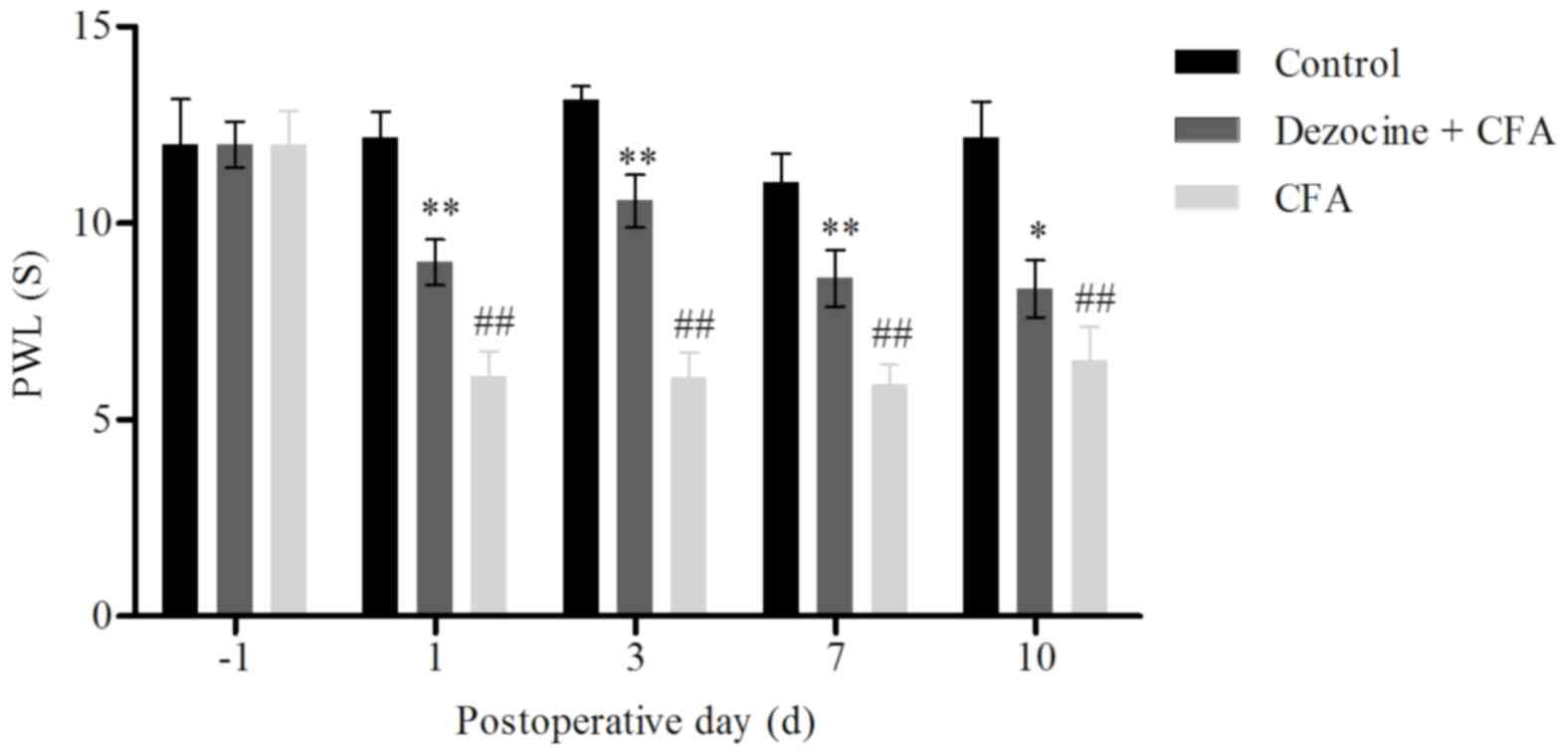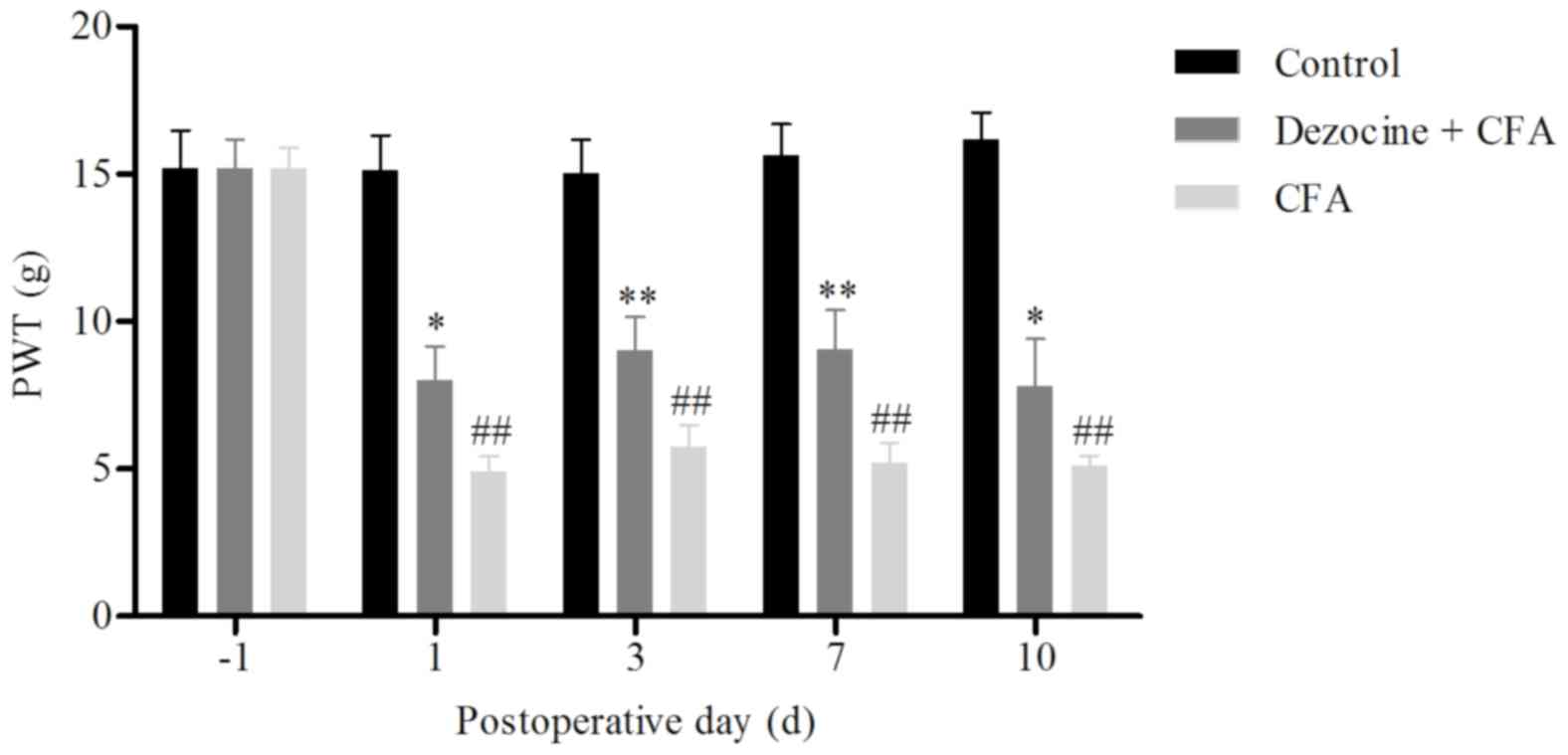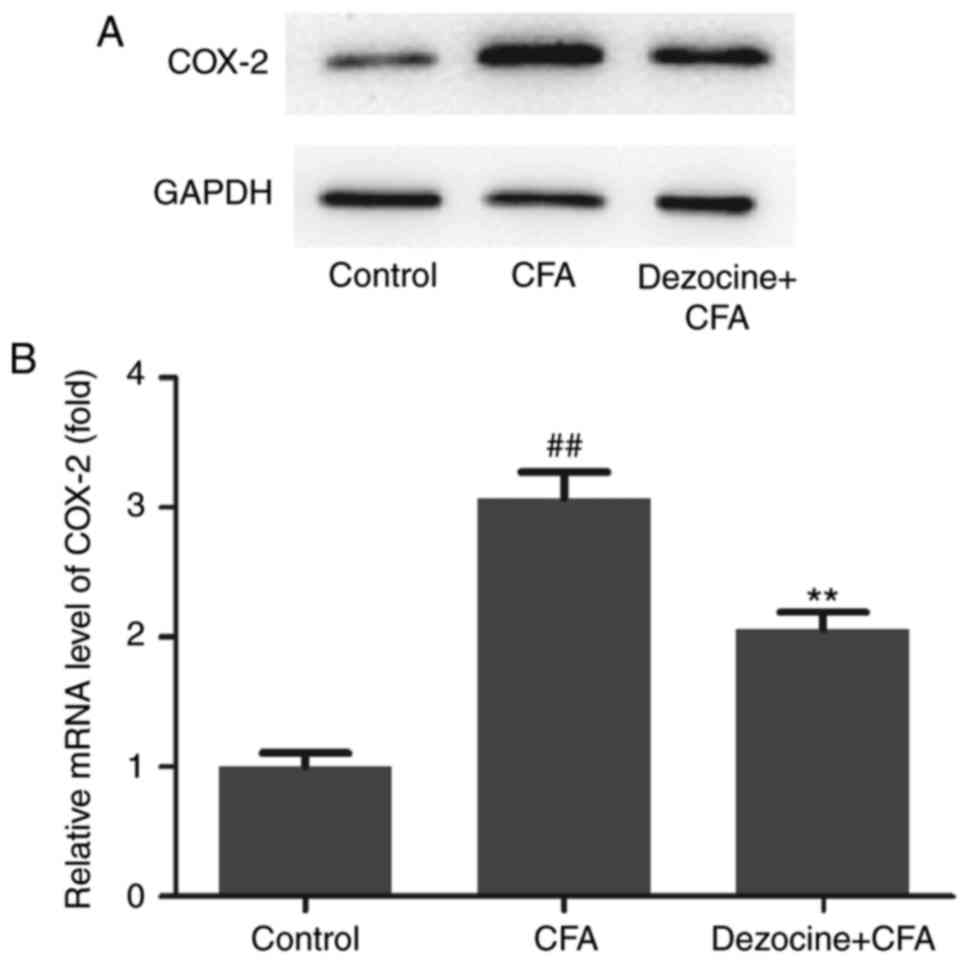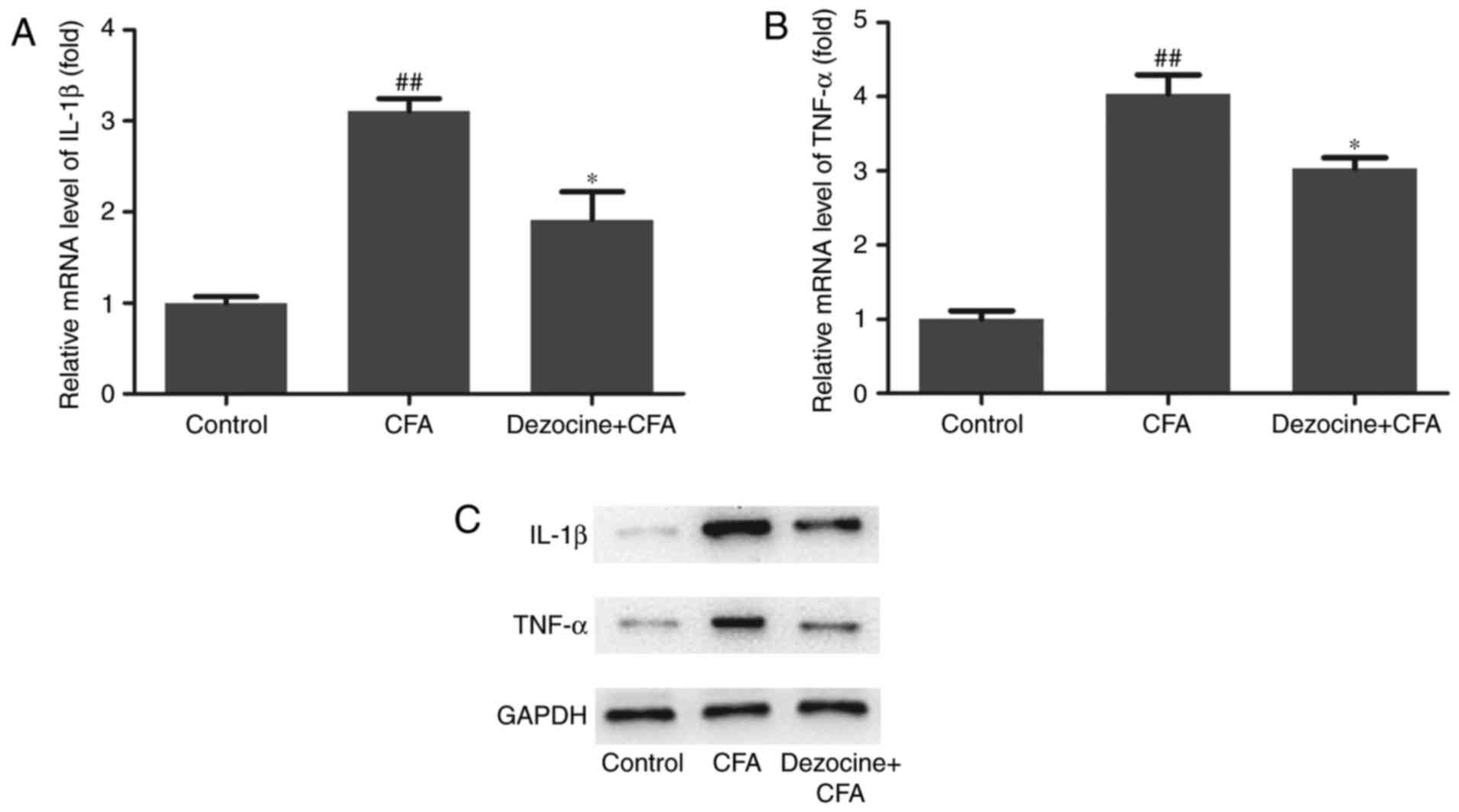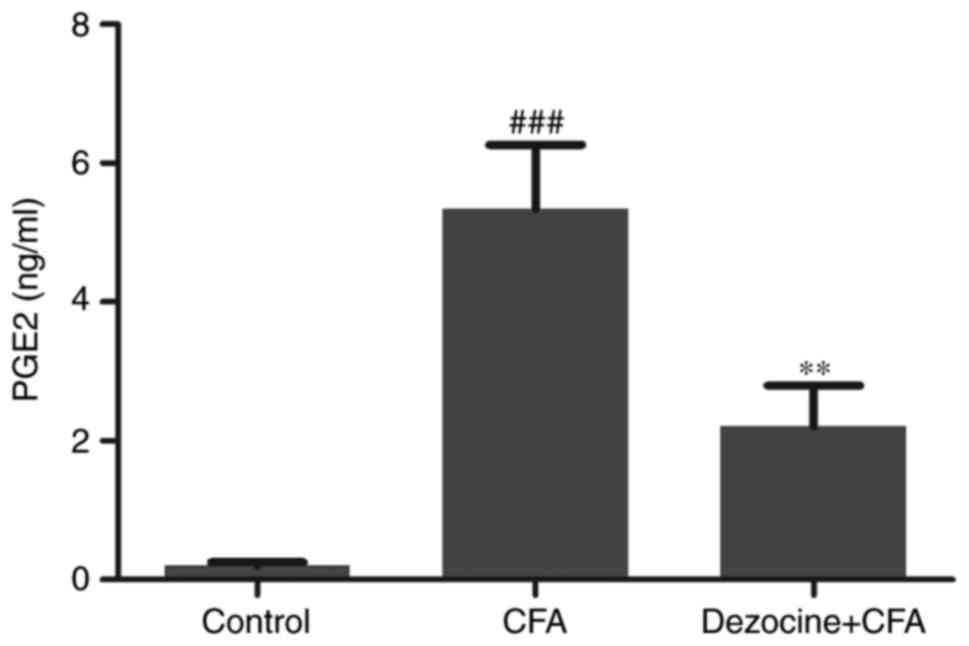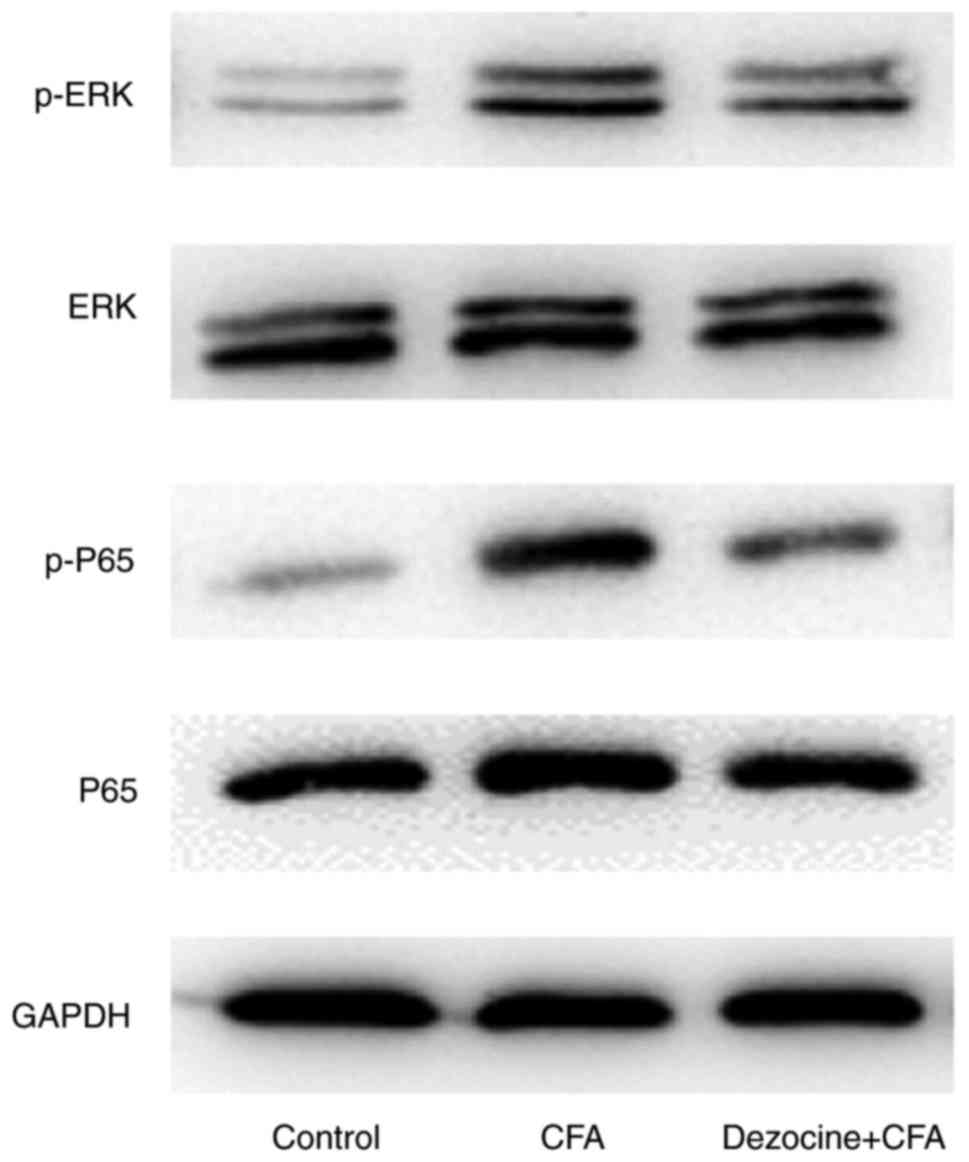Antinociceptive effects of dezocine on complete Freund's adjuvant‑induced inflammatory pain in rats
- Authors:
- Published online on: April 30, 2018 https://doi.org/10.3892/etm.2018.6110
- Pages: 5469-5474
Abstract
Introduction
Pain has been classified into three different categories by Woolf et al (1) and Woolf (2), including nociceptive, inflammatory and pathological pain. Tissue damage and infiltration of immune cells have been suggested to be associated with inflammatory pain, while pathological pain is considered to be induced by damage or abnormal function of the nervous system (1,2).
Inflammatory pain, a complicated pathological process that occurs at the central and peripheral nervous systems, severely impacts the life quality of patients. Mitogen activated protein kinase (MAPK) is a type of protein kinase specific to the amino acids tyrosine, threonine and serine, and is known to modulate cell proliferation, differentiation, mitosis, survival and apoptosis (3). In addition, the MAPK family, which is located in the spinal cord, has been reported to modulate inflammatory pain (4). Furthermore, extracellular signal-regulated kinase 1/2 (ERK1/2) was verified to be activated in inflammatory pain that was induced by complete Freund's adjuvant (CFA) (5).
The features of inflammation are known to include accumulation of various pro-inflammatory cytokines and prostaglandins, as well as increased expression of cyclooxygenase-2 (COX-2) (6,7). Notably, ERK1/2 activation followed by COX-2 expression was identified to serve a crucial role in generating inflammatory pain (8).
Dezocine is an effective opioid analgesic and has been used for the treatment of pain (9). A previous study has demonstrated that dezocine may be a novel molecular target, with clinical implications (10). Dezocine was also revealed to antagonize morphine analgesia upon simultaneous administration in mice models of acute nociception (11). In the current study, the aims were to examine the effects of dezocine on a CFA-induced inflammatory pain model in rats and to investigate the possible underlying molecular mechanisms.
Materials and methods
Animals
Animal care and handling procedures were approved by the Northwest University for Nationalities (Yinchuan, China), and conducted according to the National Institutes of Health Guide for the Care and Use of Laboratory Animals. A total of 30 adult male (6–8 weeks) Sprague-Dawley rats (weight, 220–250 g) were obtained from Department of Anesthesiology, the Northwest University for Nationalities (Yinchuan, China). Rats were housed under controlled temperature (23±1°C), humidity (70±10%) and 12-h light/dark lighting, and were provided with distilled water and food ad libitum.
Rats were randomly divided into three groups as follows: i) Control group, subcutaneously injected with 100 µl saline (n=10); ii) CFA group, subcutaneously injected with 100 µl CFA (Sigma-Aldrich; Merck KGaA, Darmstadt, Germany; n=10); and iii) dezocine+CFA group, pretreated with 1 ml dezocine injection (0.4 µg/kg) at 30 min before 100 µl CFA injection in the plantar surface of right hind paw (n=10). Subsequently, the rats were anesthetized with 10% choral hydrate (0.35 ml/100 g; intraperitoneal injection) and the ipsilateral spinal cord (L4-L6) was removed on the 10th day following experimentation, immediately applied for the extraction of mRNA and protein for the determination of mRNA level and protein level, respectively.
Behavioral testing
At 1 day before the experiment (baseline) and 6 h after CFA injection, the paw withdrawal threshold (PWT) and paw withdrawal latency (PWL) of the rats were measured with an automated von Frey testing device (Dynamic Plantar Aesthesiometer 37450; Ugo Basile, Gemonio, Italy). Rats were allowed to adapt to the new environment for ~30 min. A steel rod (0.5 mm diameter) was then pushed against the hind paw of the rat with an ascending force between 0 and 50 × g over a period of 20 sec. The mechanical stimulus was stopped when the rat withdrew its hind paw and the corresponding force and latency were recorded.
Western blot analysis
The ipsilateral lumbar 4–6 spinal cord samples obtained from the rats were homogenized in lysis buffer containing a mixture of phosphatase and proteinase inhibitors (Roche Diagnostics Ltd., Burgess Hill, UK). Next, the protein concentration was determined using a BCA assay kit (Beyotime Institute of Biotechnology, Haimen, China), protein sample (10 µg) was separated by 8–12% SDS-polyacrylamide gel electrophoresis and transferred onto nitrocellulose membranes (EMD Millipore, Billerica, MA, USA). Subsequent to blocking the membranes with 5% skim milk at 37°C for 1 h, the samples were incubated overnight at 4°C with primary antibodies: COX-2 (cat. no. 12282, 1:1,000; Cell Signaling Technology, Inc., Danvers, MA, USA); IL-1β (cat. no. I2393, 1:1,000; Sigma, St. Louis, MO, USA); TNF-α (cat. no. OAAB21998, 1:1,000; Aviva Systems BIOLOGY, San Diego, CA, USA); p-ERK1/2 (cat. no. 5726, 1:1,000; Cell Signaling Technology, Inc.); ERK1/2 (cat. no. 4696, 1:1,000; Cell Signaling Technology, Inc.); P65 (cat. no. 8242, 1:1,000; Cell Signaling Technology, inc.) and p-P65 (cat. no. 3033, 1:1,000; Cell Signaling Technology, Inc.). The membranes were incubated for 1 h at 37°C with the horseradish peroxidase-conjugated secondary antibody (1:10,000; Cell Signaling Technology). GAPDH antibody (1:1,000; Cell Signaling Technology) was used as internal control. The bands were visualized by an enhanced chemiluminescence kit (Thermo Fisher Scientific, Inc., Waltham, MA, USA).
Enzyme-linked immunosorbent assay (ELISA)
The prostaglandin E2 (PGE2) level in the protein samples was measured by a Parameter™ PGE2 Immunoassay ELISA kit (R&D Systems, USA) according to the manufacturer's protocol.
Reverse transcription-quantitative polymerase chain reaction (RT-qPCR)
Total RNA from the ipsilateral lumbar 4–6 spinal cord specimens was extracted using TRIzol reagent (Invitrogen; Thermo Fisher Scientific, Inc.) according to the manufacturer's protocol. The RNA concentration was then quantified by spectrophotometry. Next, cDNA was synthesized from 1 µg RNA by PrimerScript RT reagent kit with gDNA Eraser (Takara Bio, Inc., Otsu, Japan). qPCR was subsequently conducted with a CFX96™ real-time PCR detection system (Bio-Rad Laboratories, Inc., Hercules, CA, USA). The PCR mixture contained 5 µl RT-qPCR mix (Takara Bio, Inc.), 0.5 µl forward primer (GenScript Co., Ltd., Nanjing, China) and 0.5 µl reverse primer (GenScript Co., Ltd.), 1 µl cDNA and 3 µl ddH2O (Invitrogen; Thermo Fisher Scientific, Inc.). Reactions were incubated at 95°C for 3 min, followed by 40 cycles of 10 sec at 95°C and 30 sec at 55.9°C. The primers utilized were as follows: IL-1β forward primer 5′-AGAGTGTGGATCCCAAACAA-3′, reverse primer 5′-AGTCAACTATGTCCCGACCA-3′. TNF-α forward primer 5′-TTCTCATTCCTGCTTGTG-3′, reverse primer 5′-TTGGTGGTTTGCTACG-3′. COX-2 forward primer 5′-CACGGACTTGCTCACTTTGTT-3′, reverse primer 5′-AAGCGTTTGCGGTACTCATT-3′. GAPDH forward primer 5′-TGCTGAGTATGTCGTGGAG-3′, reverse primer 5′-GTCTTCTGAGTGGCAGTGAT-3′. The quantification cycle (Cq) value was used for the detection of gene expression levels according to the formula 2−ΔΔCq, with GAPDH serving as the internal control (12).
Statistical analysis
Data were analyzed using GraphPad Prism5 software (GraphPad Software, Inc., La Jolla, CA, USA). Data are expressed as the mean ± standard error of the mean. Analysis of variance followed by a post-hoc Newman Keuls was used for independent samples to compare differences between groups. P<0.05 was considered to indicate a statistically significant difference.
Results
Effect of dezocine on rat behavior as a result of inflammatory pain
At 6 h after CFA injection, the rats began to limp and to guard their injected limb. The PWL and PWT values were measured in rats of the three groups at days 1, 3, 7 and 10 after the corresponding treatments. A statistically significant difference was identified among the control, CFA and dezocine+CFA groups. The PWL and PWT values of the rat hind paw in the CFA group were significantly decreased as compared with those in the control group (P<0.01). However, upon pre-administration of dezocine, the PWL and PWT values in the dezocine+CFA group were significant higher compared with those in the CFA group (P<0.01; Figs. 1 and 2). These results were consistent with the findings of a previous study, which also detected the effects of dezocine in pain behavior (13). In conclusion, the results of the behavioral tests suggested that dezocine successfully reduced CFA-induced inflammatory pain in rats.
Effect of dezocine on COX-2 expression
To detect whether a COX-2 response was induced by the analgesic effect of dezocine, the mRNA and protein expression levels of COX-2 in the rat spinal cord were assessed. The results demonstrated that, compared with the control group, CFA evidently induced the protein expression of COX-2, whereas dezocine pretreatment markedly inhibited the upregulation of COX-2 protein level that was caused by CFA administration (Fig. 3A). In addition, the mRNA expression profile of COX-2 in the different groups was detected by RT-qPCR. It was observed that the mRNA expression of COX-2 in the CFA-treated group was significantly upregulated as compared with that of the control group (P<0.01). By contrast, COX-2 mRNA expression was significantly downregulated by pretreatment with dezocine (P<0.01; Fig. 3B).
Effect of dezocine on the expression levels of interleukin (IL)-1β and tumor necrosis factor (TNF)-α
To detect whether IL-1β and TNF-α responses were caused by the analgesic effect of dezocine, the mRNA and protein expression levels of IL-1β and TNF-α in the spinal cord samples were also assessed. The results revealed that, compared with the control group, CFA significantly induced the mRNA expression levels of IL-1β and TNF-α (P<0.01), whereas dezocine pretreatment inhibited the upregulation of these levels resulting from CFA injection (P<0.05; Fig. 4A and B). Furthermore, the protein expression levels of IL-1β and TNF-α were detected by western blot analysis. The results revealed that the protein expression levels of IL-1β and TNF-α in the CFA group were clearly upregulated compared with those in the control group, while these levels were evidently downregulated by pretreatment with dezocine (Fig. 4C).
Effect of dezocine on PGE2 expression level
PGE2 levels in the different groups were measured by ELISA. The results revealed a significant increase of the PGE2 protein level in the CFA group compared with that in the control group (P<0.001). By contrast, pre-exposure to dezocine in rats injected with CFA led to an evident decrease in the PGE2 protein level as compared with that in rats injected with CFA alone (P<0.01; Fig. 5).
Effect of dezocine on the phosphorylated (p)-ERK1/2 and p-p65 protein levels
Compared with rats in the control group, the peripheral inflammation in rats that was generated by injection with CFA led to the induction of p-ERK1/2 and p-p65 levels. However, the phosphorylation levels were reduced by dezocine pretreatment in dezocine+CFA rats as compared with those in the CFA group (Fig. 6).
Discussion
In the present study, the effects of dezocine on CFA-induced inflammatory pain in rats and the possible underlying molecular mechanisms were investigated. It was observed that CFA induced peripheral inflammatory pain in rats and downregulated the PWT and PWL values; however, these were significantly alleviated upon dezocine pretreatment. In addition, the p-p65, p-ERK1/2, COX-2, PGE2, IL-1β and TNF-α levels were markedly upregulated following CFA injection, and this upregulation was suppressed by dezocine pretreatment. Taken together, the analgesic effect of dezocine on inflammatory pain induced by CFA may be associated with the inhibition of the spinal ERK1/2-COX-2 pathway.
A rat model of inflammatory plain was established in the present study subcutaneous injection with 100 µl CFA, while 1 ml dezocine (0.4 µg/kg) was injected at 30 min prior to CFA administration in order to examine the effects of dezocine on CFA-induced inflammatory pain in rats. At 1 day before the establishment of the rat model and 6 h after CFA injection at days 1, 3, 7 and 10, the PWT and PWL were measured with a dynamic plantar esthesiometer. The results revealed that the PWL and PWT values of rats in the CFA group were significantly higher in comparison with those of the control group, while pre-administration of dezocine significantly increased these values in the dezocine+CFA group (Figs. 1 and 2). These observations suggested that dezocine reduced the CFA-induced inflammatory pain in rats. However, the molecules that were responsible for these alterations required further investigation.
The inflammatory process involves the accumulation of pro-inflammatory cytokines, prostaglandins and COX-2 (6,7). A large number of studies have indicated that certain cytokines directly stimulated nociceptors (14–16). Furthermore, elevated mRNA and protein levels of IL-1β/TNF-α were identified in the anterior cingulate cortex (16), which area was indispensable for formalin-induced pain (17). Thus, in the current study, the ipsilateral sides of the lumbar spinal cord were harvested for detection of the expression levels of COX-2, IL-1β and TNF-α. It was identified that, as compared with the control group, CFA significantly increased the mRNA and protein expression levels of COX-2, IL-1β and TNF-α, while dezocine pretreatment inhibited the upregulation of these factors (Figs. 3 and 4).
Under pathological conditions, COX-2 produces PGE2 at a 10–20-times higher rate in comparison with the physiological levels (18). The ELISA results in the current study further revealed a significant increase of the PGE2 protein level in the CFA group as compared with the control group, while prior exposure of CFA-injected rats to dezocine led to a clear decrease in PGE2 protein as compared with the untreated CFA-injected rats (Fig. 5).
The MAPK family kinases are expressed in the spinal cord and have been reported to regulate inflammatory pain (4). A previous study revealed that ERK1/2 was activated in CFA-induced inflammatory pain (5). Furthermore, ERK1/2 activation followed by COX-2 expression was observed to serve a pivotal role in generating inflammatory pain (8). Nuclear factor (NF)-κB is a heterodimeric nuclear factor (p50 and p65) that is widely expressed in the central nervous system (19,20). In addition, the cytokines IL-1β and TNF-α, which are released after stress, have been reported to also induce the activation of NF-κB (6). In the present study, compared with rats in the control group, the peripheral inflammation in CFA-injected rats was observed to lead to the induction of p-ERK1/2 and p-p65 in the ipsilateral lumbar 4–6 spinal cord, whereas these levels were reduced by dezocine pretreatment as compared with those in the CFA group (Fig. 6).
In conclusion, the analgesic effect of dezocine on inflammatory pain induced by CFA was associated with the activation inhibition of the spinal ERK1/2-COX-2 signaling pathway. Taken together, the current study demonstrated a novel treatment for inflammatory pain in rats, which may be helpful for the treatment of inflammatory pain in clinical patients in the future.
Competing interests
The authors declare that they have no competing interests.
References
|
Woolf CJ, Bennett GJ, Doherty M, Dubner R, Kidd B, Koltzenburg M, Lipton R, Loeser JD, Payne R and Torebjork E: Towards a mechanism-based classification of pain? Pain. 77:227–229. 1998. View Article : Google Scholar : PubMed/NCBI | |
|
Woolf CJ: What is this thing called pain? J Clin Investig. 120:3742–3744. 2010. View Article : Google Scholar : PubMed/NCBI | |
|
Pearson G, Robinson F, Gibson Beers T, Xu BE, Karandikar M, Berman K and Cobb MH: Mitogen-activated protein (MAP) kinase pathways: Regulation and physiological functions. Endoc Rev. 22:153–183. 2001. View Article : Google Scholar | |
|
Ji RR, Kohno T, Moore KA and Woolf CJ: Central sensitization and LTP: Do pain and memory share similar mechanisms? Trends Neurosci. 26:696–705. 2003. View Article : Google Scholar : PubMed/NCBI | |
|
Adwanikar H, Karim F and Gereau RW IV: Inflammation persistently enhances nocifensive behaviors mediated by spinal group I mGluRs through sustained ERK activation. Pain. 111:125–135. 2004. View Article : Google Scholar : PubMed/NCBI | |
|
Allan SM and Rothwell NJ: Inflammation in central nervous system injury. Philos Trans R Soc Lond B Biol Sci. 358:1669–1677. 2003. View Article : Google Scholar : PubMed/NCBI | |
|
Lucas SM, Rothwell NJ and Gibson RM: The role of inflammation in CNS injury and disease. Br J Pharmacol. 147 Suppl 1:S232–S240. 2006. View Article : Google Scholar : PubMed/NCBI | |
|
Park JW, Choi YJ, Suh SI and Kwon TK: Involvement of ERK and protein tyrosine phosphatase signaling pathways in EGCG-induced cyclooxygenase-2 expression in Raw 264.7 cells. Biochem Biophys Res Commun. 286:721–725. 2001. View Article : Google Scholar : PubMed/NCBI | |
|
O'Brien JJ and Benfield P: Dezocine. A preliminary review of its pharmacodynamic and pharmacokinetic properties, and therapeutic efficacy. Drugs. 38:226–248. 1989.PubMed/NCBI | |
|
Liu R, Huang XP, Yeliseev A, Xi J and Roth BL: Novel molecular targets of dezocine and their clinical implications. Anesthesiology. 120:714–723. 2014. View Article : Google Scholar : PubMed/NCBI | |
|
Li NN, Huang YQ, Huang LE, Guo SH, Shen MR, Guo CL, Zhu SM and Yao YX: Dezocine antagonizes morphine analgesia upon simultaneous administration in rodent models of acute nociception. Pain Physician. 20:E401–E409. 2017.PubMed/NCBI | |
|
Livak KJ and Schmittgen TD: Analysis of relative gene expression data using real-time quantitative PCR and the 2(-Delta Delta C(T)) method. Methods. 25:402–408. 2001. View Article : Google Scholar : PubMed/NCBI | |
|
Wu FX, Pan RR, Yu WF and Liu R: The anti-nociception effect of dezocine in a rat neuropathic pain model. Transl Perioper Pain Med. 1:5–8. 2014.PubMed/NCBI | |
|
Opree A and Kress M: Involvement of the proinflammatory cytokines tumor necrosis factor-alpha, IL-1 beta, and IL-6 but not IL-8 in the development of heat hyperalgesia: Effects on heat-evoked calcitonin gene-related peptide release from rat skin. J Neurosci. 20:6289–6293. 2000. View Article : Google Scholar : PubMed/NCBI | |
|
Obreja O, Rathee PK, Lips KS, Distler C and Kress M: IL-1 beta potentiates heat-activated currents in rat sensory neurons: Involvement of IL-1RI, tyrosine kinase, and protein kinase C. FASEB J. 16:1497–1503. 2002. View Article : Google Scholar : PubMed/NCBI | |
|
Lu Y, Zhu L and Gao YJ: Pain-related aversion induces astrocytic reaction and proinflammatory cytokine expression in the anterior cingulate cortex in rats. Brain Res Bull. 84:178–182. 2011. View Article : Google Scholar : PubMed/NCBI | |
|
Johansen JP, Fields HL and Manning BH: The affective component of pain in rodents: Direct evidence for a contribution of the anterior cingulate cortex. Proc Natl Acad Sci USA. 98:8077–8082. 2001. View Article : Google Scholar : PubMed/NCBI | |
|
Seibert K, Masferrer J, Zhang Y, Leahy K, Hauser S, Gierse J, Koboldt C, Anderson G, Bremer M, Gregory S, et al: Expression and selective inhibition of constitutive and inducible forms of cyclooxygenase. Adv Prostaglandin Thromboxane Leukot Res. 23:125–127. 1995.PubMed/NCBI | |
|
Baldwin AS Jr: The NF-kappa B and I kappa B proteins: New discoveries and insights. Ann Rev Immunol. 14:649–683. 1996. View Article : Google Scholar | |
|
Ghosh S, May MJ and Kopp EB: NF-kappa B and Rel proteins: Evolutionarily conserved mediators of immune responses. Ann Rev Immunol. 16:225–260. 1998. View Article : Google Scholar |



